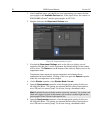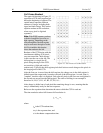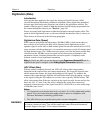
58 PIXIS System Manual Version 2.C
Once the target array temperature {Temperature Setpoint} has been set, the software
controls the camera's cooling circuits to reach set array temperature. On reaching that
temperature, the control loop locks to that temperature for stable and reproducible
performance. When temperature lock has been reached (temperature within 0.05°C of set
value), the current temperature is Locked. The on-screen indication allows easy
verification of temperature lock.
The time required to achieve lock can vary over a considerable range, depending on such
factors as the camera type, CCD array type, ambient temperature, etc. Once lock occurs,
it is okay to begin focusing. However, you should wait an additional twenty minutes
before taking quantitative data so that the system has time to achieve optimum thermal
stability.
The deepest operating temperature for a system depends on the CCD array size and
packaging. Refer to Table 5, on page 95, for typical deepest cooling temperatures.
Note: In WinX, the Detector Temperature dialog will not display temperature
information while you are acquiring data.
Dark Charge
Dark charge (or dark current) is the thermally induced buildup of charge in the CCD over
time. The statistical noise associated with this charge is known as dark noise. Dark charge
values vary widely from one CCD array to another and are exponentially temperature
dependent. In the case of cameras with MPP type arrays, the average dark charge is
extremely small. However, the dark-charge distribution is such that a significant number
of pixels may exhibit a much higher dark charge, limiting the maximum practical
exposure. Dark charge effect is more pronounced in the case of cameras having a non-
MPP array (such as deep-depletion devices).
With the light into the camera completely blocked, the CCD will collect a dark charge
pattern, dependent on the exposure time and camera temperature. The longer the
exposure time and the warmer the camera, the larger and less uniform this background
will appear. Thus, to minimize dark-charge effects, you should operate with the lowest
CCD temperature possible.
Note: Do not be concerned about either the DC level of this background. What you see
is not noise. It is a fully subtractable bias pattern. Simply acquire and save a dark charge
"background image" under conditions identical to those used to acquire the "actual"
image. Subtracting the background image from the actual image will significantly reduce
dark-charge effects.
If you observe a sudden change in the baseline signal, there may be excessive humidity in
the camera vacuum enclosure. Turn off the camera and contact Princeton Instruments
Customer Support. See page 132 for contact information.
Saturation
When signal levels in some part of the image are very high, charge generated in one pixel
may exceed the "well capacity" of the pixel, spilling over into adjacent pixels in a process
called "blooming." In this case a shorter exposure is advisable, with signal averaging to
enhance S/N (Signal-to-Noise ratio) accomplished through the software.
WARNING!


















